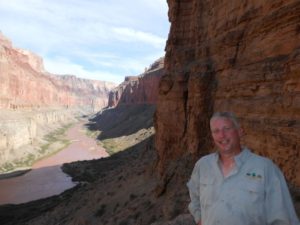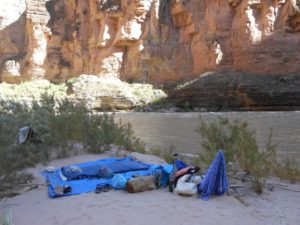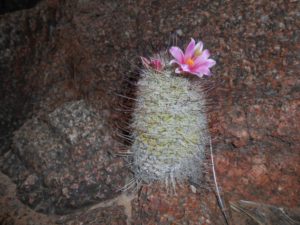There are no man-made signs deep in the Grand Canyon. If you want to know where to find Elves Chasm or how severe the next set of Colorado River rapids are, you better have a good guidebook with you or be under the care of expert navigators.
There are no picnic tables. You have to make do with sitting on rocks, sand or your raft, flicking your lunch’s crumbs into the river’s current for fish to finish off.
There are no restrooms. Peeing into the flowing milk chocolate river or squatting over a metal can are the only options. And you’re usually conducting your business mere feet from fellow travelers.
That river also serves as your bathtub, should you feel the need to scrub away the day’s dirt and sweat. You might not feel squeaky clean as you step out, but the perpetually icy water will leave you feeling rudely awake, alive and oddly insignificant. After all, you’re standing naked and shivering, or partially naked if you bring civilization’s modesty with you, before towering rock walls that have seen it all over their millions of years of patient existence.
And there are no handrails, fluorescent yellow warning tape or off-limits rope to keep you safe. One recent, tragic death attests to that. (Florida woman dies after fall from Grand Canyon trail.)
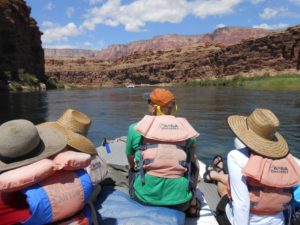 I spent a week on a raft slowly cruising through this natural wonder as a guest of the National Center for Science Education. The California based organization has been hosting these expeditions for several years, offering bucket-list travelers a unique perspective of the ancient landmark. NCSE scientists take advantage of several stops along the river to demonstrate how creationists believe the Canyon proves that Noah’s flood is historical fact and contrast that with the scientific consensus that the Canyon walls are oblivious to such a fantastic tale. The presentations are as entertaining as they are educational.
I spent a week on a raft slowly cruising through this natural wonder as a guest of the National Center for Science Education. The California based organization has been hosting these expeditions for several years, offering bucket-list travelers a unique perspective of the ancient landmark. NCSE scientists take advantage of several stops along the river to demonstrate how creationists believe the Canyon proves that Noah’s flood is historical fact and contrast that with the scientific consensus that the Canyon walls are oblivious to such a fantastic tale. The presentations are as entertaining as they are educational.
But the scientists don’t pilot the motorized rafts. That was left to a crew of bronze skinned bad-asses from Arizona Raft Adventures (AzRA). Our seven day journey is actually the speedier version. AzRa also offers tours using various paddle and oar boats that take about twice as long.
Our boat pilots, cook and swampers (assistants) were clearly river veterans who were intimately familiar with nearly every nook and cranny of our 226-mile adventure. They slipped through even the most treacherous of rapids with an expertise that never left you doubting that you would come out just fine on the other side. Grand Canyon explorers of decades past came alive through their engaging stories, which we tourists couldn’t get enough of.
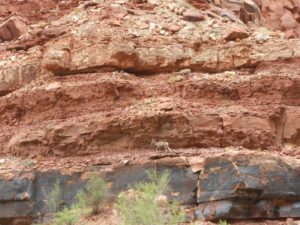
Can you spot all four bighorn sheep? There are two adults and two juveniles. The children were butting heads when we floated by.
During our exploratory hikes, the guides were akin to the Canyon’s bighorn sheep, scaling boulders and skirting narrow ledges effortlessly. And throughout it all we never felt like we were on a cheesy tourist-trap tour. Rather, we felt like eager students in the world’s biggest classroom, soaking in all the experience and knowledge our guides had to offer.
And the food! Oh my, the food! Our camp cook dished out amazing meals every single day. Who knew you could gain weight on a camping trip?
I was truly fortunate to get this adventure of a lifetime. NCSE dreamed up an excellent idea a few years ago: offer all-expense-paid scholarships to two teachers each trip. This is funded by generous donations, for which I’m so grateful. Last year, a teacher from California and one from New Hampshire filled out lengthy applications and were selected from 140 hopefuls. This year, another California teacher and I (from Florida) were the lucky recipients. Without this scholarship, there would be no way I could have ever afforded to attend.
There is a catch, though. But it’s certainly one I don’t mind. We were expected to pay attention and collect information to take back to our students in the form of lesson plans and assessments. Fortunately, that won’t be too difficult a task. I teach biology and environmental science. The Canyon is absolutely flooded (Noah pun intended) with information and ideas that should make developing lesson plans fairly easy.
One idea is to have students learn about the introduced plant tamarisk. It’s not native to the area and has caused environmental problems for decades. Why was tamarisk brought to the area? What does tamarisk do to the environment? What can and cannot be done about it? Will introducing beetles that feed on tamarisk have unintended consequences just like introducing the plant did? How is the management plan complicated by endangered birds using tamarisk for nesting?
If nothing else, this lesson can demonstrate how complicated situations like this can become. Students need to absorb an important point of this lesson: there are no simple answers.
Another idea is to learn how Glen Canyon Dam has affected the Colorado River. When it was constructed and opened for business, no thought was given to the impact on the river’s ecosystem. Water was withheld and released into the river from the dam strictly based on cities’ electrical needs. I teach my students that dams are considered an alternative energy source to fossil fuels. But I emphasize that there are consequences, too.
Those consequences to the Colorado River are now being realized and studied, leading to such efforts as “give insects the weekend off” to allow insects to lay their eggs in a consistently wet, stable environment, at least temporarily. The important point in this lesson: how can we balance the needs of humans with the needs of nature?
There are so many more lessons. The Grand Canyon is a time machine, recording in rock the abiotic and biotic stories of past millenniums. I saw still embedded in splintered boulders fossilized footprints of an ancient critter and the distinct outlines of fantastic sea creatures long extinct.
The formal lessons are just one aspect of my adventure I’ll take back with me to the classroom. I plunged through white water rapids from benign Nankoweap Rapid (rated at an intensity of 3 on the Colorado River’s 10-point scale) to white knuckle Lava Falls Rapid (spiking the intensity meter at 10). I had nothing protecting me but my tightly-cinched life vest, two good grips on cargo straps and the expertise of the raft’s driver.
And seeing a recently abandoned raft wedged into rocks in the middle of one set of furious rapids really sends home the point that this isn’t a Disneyworld ride. Sometimes, things do go wrong. I’m glad I didn’t experience that first hand.
Our daily hikes not only allowed us to stretch our legs after hours on the raft, but showed us natural beauties you can’t possibly guess existed if you were to only stand on the Canyon’s rim and gaze into the depths for a few minutes. (The average Grand Canyon tourist visit is only 45 minutes.) There are smooth, water-sculpted side canyons half in shadow and half in sunlight. There are clear streams cascading down natural rock steps. There’s a special, relaxing joy to be felt walking up the middle of such streams, being careful not to slip on moss or step on tadpoles.
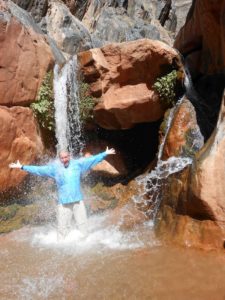 There’s an amazing array of waterfalls tucked away in secret spots. I stood under some to feel their gushing force pound my shoulders. The one in aptly named Elves Chasm was the very definition of enchanting. I swam in a deep pool under it and passed through to a cave. A slippery climb behind the falls brings you up to a smooth ledge from which you can launch yourself from the falls back into the pool below. I almost expected faeries to be flitting about.
There’s an amazing array of waterfalls tucked away in secret spots. I stood under some to feel their gushing force pound my shoulders. The one in aptly named Elves Chasm was the very definition of enchanting. I swam in a deep pool under it and passed through to a cave. A slippery climb behind the falls brings you up to a smooth ledge from which you can launch yourself from the falls back into the pool below. I almost expected faeries to be flitting about.
Nights were just as special as the days. Most folks popped up tents on the first night due to the threat of rain that never actually materialized. But all other nights were spent exposed to raw nature and the dazzling array of stars. It was usually too hot to even slip inside a sleeping bag.
The Big Dipper stood out dramatically as shooting stars blazed through the atmosphere and distant satellites drifted between horizons. It was easy to spend hours just gazing up. No movie or television screen can display such an inspiring view.
But I eventually slept, only to be startled awake once at dawn by a frog plopping onto my leg. It sat there for a moment, apparently not caring what it had landed on and only hopped away when I shook my leg. Good morning.
If I had it to do all over again with the benefit of this experience to guide me, I would have packed fewer items. I didn’t need half of what I brought, especially the underwear. Yes, I went a week without underwear. Constant soakings in the rapids would have brought on uncomfortable chaffing from cotton whitey tighties.
I sunburn very easily and so I’m proud to say that my meticulous efforts to avoid it were successful. I wore long pants and long-sleeved shirts that were lightweight and fast drying. I wore a hat and even gloves. All other exposed skin I slathered with sunscreen a few times a day. The item I regretted not bringing was Chap Stick. My lips were cracked and bleeding by the end of the trip.
My flashlight and water bottles were necessities as were my Tevas, which were awesome for the many “wet hikes” we took. Polypropylene undershirts kept my body temperature as comfortably regulated as was possible when alternating between the desert heat and teeth-chattering cold river water that kept swamping the boats in the rapids. A sarong kept me covered when I changed clothes in camp and kept me cool during the day when soaked in the cold river. As the guides kept reminding us in the blazing heat: if you’re hot, you’re stupid. Don’t be stupid. There is cold water all around you.
There were a lot of memories packed into that one week. Admittedly, there were times when I was tired, grumpy and uncomfortable. But I have no doubt those annoyances will eventually fade from memory. All I’m going to remember is that I spent a week truly immersed in nature. There were no billboards or McDonalds or honking horns.
And there were no cell phones.





